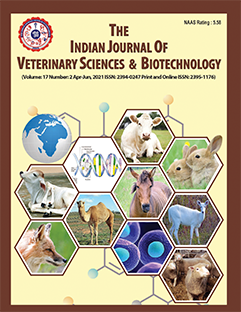Clinico-Epidemiological and Allergens Profiles of Dogs with Canine Atopic Dermatitis from Haryana, India
DOI:
https://doi.org/10.48165/ijvsbt.21.6.12Keywords:
Allergens profile, Canine atopic dermatitis, Clinico-epidemiology, Dogs, HaryanaAbstract
The present investigation was conducted to study the clinico-epidemiology and allergens profile of canine atopic dermatitis (CAD) in dogs in and around Hisar, Haryana (India). A total of 46 dogs with pruritic dermatological conditions presented at Veterinary Clinical Complex of the College from April to October, 2022 were screened as per the Favrot’s criteria of diagnosis of CAD and ruling out other dermatological conditions. Allergens profile of CAD in dogs was established using intradermal testing with a panel of allergens. Clinico epidemiological investigation revealed CAD (45.65%) to be the most common pruritic skin diseases diagnosed, followed by bacterial dermatitis (13.04%) and pyodemodicosis (13.04%) in pruritic dogs. Labrador retriever was the most common breed of dog affected with CAD, followed by Pitbull with age predisposition between 6 months to 3 years. Axillae, forepaws and hind paws were the most common body sites affected with lesions of atopic dermatitis. All the affected dogs qualified ≥6 clinical features of Favrot’s criteria of CAD with affection of front feet and ear pinnae, sparing the dorso-lumbar area and ear margins. Allergens profile of CAD in affected dogs revealed both indoor (house dust mites, molds, house dust) and outdoor allergens (plant pollens, allergens of cockroach and mosquitoes) to be the frequent causes of CAD in dogs in study area. Accordingly, the living environment of the dogs can be adjusted to avoid the allergen exposure in affected dogs.
Downloads
References
Bhagya, B.K., Kamran, C.A., Ramesh, P.T., & Veeregowda, B.M. (2021). Dermatological diseases in pugs with special reference to canine atopic dermatitis. Journal of Entomology and Zoology Studies, 9(1), 1846–1852.
Bizikova, P., Santoro, D., Marsella, R., Nuttall, T., Eisenschenk, M.N., & Pucheu-Haston, C.M. (2015). Review: Clinical and histological manifestations of canine atopic dermatitis. Veterinary Dermatology, 26(2), 79–e24.
Brar, R.K., Dhaliwal, P.S., Kumar, A., Chhabra, S., & Uppal, S.K. (2017). Clinico-pathological studies on atopic dermatitis in dogs. Journal of Animal Research, 7(3), 507–513.
Favrot, C. (2009). Clinical signs and diagnosis of canine atopic dermatitis. European Journal of Companion Animal Practice, 19(3), 219–222.
Favrot, C., Steffan, J., Seewald, W., & Picco, F. (2010). A prospective study on the clinical features of chronic canine atopic dermatitis and its diagnosis. Veterinary Dermatology, 21(1), 23–31.
Garland, M. (2013). Introduction to canine skin and dermatology. Veterinary Nursing Journal, 28(4), 131–133.
Griffen, C.E., & DeBoer, D.J. (2001). The ACVD task force on canine atopic dermatitis (XIV): Clinical manifestations of canine atopic dermatitis. Veterinary Immunology and Immunopathology, 81, 255–269.
Halliwell, R. (2006). Revised nomenclature for veterinary allergy. Veterinary Immunology and Immunopathology, 114(3–4), 207–208.
Harvey, N.D., Shaw, S.C., Craigon, P.J., Blott, S.C., & England, G. (2019). Environmental risk factors for canine atopic dermatitis: A retrospective large-scale study in Labrador and golden retrievers. Veterinary Dermatology, 30(5), 396–e119.
Hensel, P., Santoro, D., Favrot, C., Hill, P., & Griffin, C. (2015). Canine atopic dermatitis: Detailed guidelines for diagnosis and allergen identification. BMC Veterinary Research, 11(1), 1–13.
Hill, P.B., & DeBoer, D.J. (2001). The ACVD task force on canine atopic dermatitis (IV): Environmental allergens. Veterinary Immunology and Immunopathology, 81(3–4), 169–186.
Hill, P., Lo, A., Eden, C.A.N., Huntley, S., Morey, V., Ramsey, S., & Williams, V. (2006). Survey of the prevalence, diagnosis and treatment of dermatological conditions in small animals in general practice. Veterinary Record, 158(16), 533–539.
Hubbard, T.L., & White, P.D. (2011). Comparison of subjective and objective intradermal allergy test scoring methods in dogs with atopic dermatitis. Journal of the American Animal Hospital Association, 47(6), 399–405.
Jaeger, K., Linek, M., Power, H.T., Bettenay, S.V., Zabel, S., Rosychuk, R.A., & Mueller, R.S. (2010). Breed and site predispositions of dogs with atopic dermatitis: A comparison of five locations in three continents. Veterinary Dermatology, 21(1), 118–122.
Jyothi, J., Kumar, K.S., Nagaraj, P., Reddy, K.C., & Rao, T.M. (2013). Diagnostic and therapeutic management of canine atopic dermatitis. Intas Polivet, 14(2), 245–252.
Khurana, R., Kumar, T., Agnihotri, D., & Sindhu, N. (2016). Dermatological disorders in canines – A detailed epidemiological study. The Haryana Veterinarian, 55(1), 97–99.
Kim, H.J., Kang, M.H., & Park, H.M. (2011). Common allergens of atopic dermatitis in dogs: Comparative findings based on intradermal tests. Journal of Veterinary Science, 12(3), 287–290.
Mazrier, H., Vogelnest, L.J., Thomson, P.C., Taylor, R.M., & Williamson, P. (2016). Canine atopic dermatitis: Breed risk in Australia and evidence for a susceptible clade. Veterinary Dermatology, 27(3), 167–e42.
Miller, W.H. Jr., Griffin, C.E., & Campbell, K.L. (2013). Diagnostic methods. In Muller and Kirk’s Small Animal Dermatology (7th ed.). Saunders, Elsevier Inc., Missouri.
Moriello, K.A. (2022). Structure of the skin in dogs. In: MSD Veterinary Manual – Pet Owner Version. Retrieved from https://www.msdvetmanual.com/dog-owners/skin-disorders-of-dogs/structure-of-the-skin-in-dogs
Olivry, T., Saridomichelakis, M., Nuttall, T., Bensignor, E., Griffin, C.E., & Hill, P.B. (2014). Validation of the canine atopic dermatitis extent and severity index (CADESI)-4, a simplified severity scale for assessing skin lesions of atopic dermatitis in dogs. Veterinary Dermatology, 25(2), 77–e25.
Santoro, D. (2019). Therapies in canine atopic dermatitis: An update. The Veterinary Clinics of North America – Small Animal Practice, 49(1), 22–26.
Saridomichelakis, M.N., & Olivry, T. (2016). An update on the treatment of canine atopic dermatitis. The Veterinary Journal, 207, 29–37.
Shaw, S.C., Wood, J.L., Freeman, J., Littlewood, J.D., & Hannant, D. (2004). Estimation of heritability of atopic dermatitis in Labrador and Golden Retrievers. American Journal of Veterinary Research, 65(7), 1014–1020.
Singh, N.S., Das, G., Gonmei, C., Lalmuanpuii, R., & Shah, N. (2022). Incidence of canine atopic dermatitis (CAD) in Mizoram. Journal of Animal Research, 12(1), 111–116.
Tarpataki, N., Pápa, K., Reiczigel, J., Vajdovich, P., & Vörös, K. (2006). Prevalence and features of canine atopic dermatitis in Hungary. Acta Veterinaria Hungarica, 54(3), 353–366.*
Downloads
Published
Issue
Section
License
Copyright (c) 2025 Indian Journal of Veterinary Sciences and Biotechnology

This work is licensed under a Creative Commons Attribution-NonCommercial-NoDerivatives 4.0 International License.




